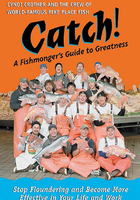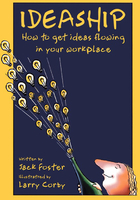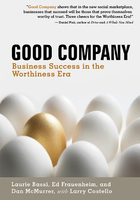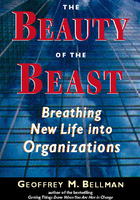Why Courage?
To live into the future means to leap into the unknown, and this requires a degree of courage for which there is no immediate precedent and which few people realize.
-Rollo May
Sigrid Wright didn't put on her seatbelt because she was moving her car only a short distance. It was December nineteenth, and she had parked her car next to the office to unload supplies for the company holiday party. The Community Environmental Council's office was on an old dairy farm and sat on a point on the Santa Barbara mesa, overlooking the valley.
It was an unusually warm and bright sunny day, even for California, and Sigrid was thinking about the press conference she was hosting that morning. As she was backing down the narrow winding driveway, her car got stuck on a bush. What happened next isn't entirely clear. She pumped the gas pedal a couple of times to get unstuck, and the car suddenly popped off the bushes and spun into a backward fishtail at a high speed over the cliff.
Sigrid's car flipped over dense chaparral and poison oak, rolling 120 feet until it landed upside down in a tree. It was the only tree on the hillside big enough to have stopped the car from tumbling another hundred feet. She was stunned, still alert in a pile of glass and blood on the inside roof of her car. She honked to alert her coworkers, hoping someone would hear and call 911. "Through courage, I guess, and probably grace too, I managed to stay conscious despite the severe head trauma."
The car was still running, so Sigrid opened the electric window and fell out the window. She then fell out of the tree, landing in poison oak. Sigrid started climbing uphill. "The EMTs and fire crews had to chainsaw their way down and really find their way to get to me."
That was in 2003. It took Sigrid many months and more courage to recover. Five years later, the 2008 stock market crash and recession called for a different kind of courage. Sigrid and her husband had to short-sell their house to stay financially afloat. Meanwhile, the Community Environmental Council's endowment shrank in half. In addition, as assistant director and one of the few staff members remaining after a massive multiyear transformation resulted in a new strategic direction for CEC, Sigrid was unclear about her growth path with the organization. Perhaps best known for hosting one of the very first Earth Day festivals in America in 1970, but since then as a "think-and-do tank," CEC has focused on deeply analyzing tough environmental problems and then applying creative, real-world solutions. That "think and do" style describes Sigrid's leadership, too.
For fifteen years, Sigrid had been in charge of the annual Earth Day festival, one of the biggest in the country. But the event was not integrated into the rest of organization's mission and received very little support. She wondered if it was time to just let it fold or to find a new way to rejuvenate it. Sigrid was feeling very stuck and unsure that her effort was going to pay off.
"We had a complete turnover in our board during that time. We also had a leadership transition in management. By the time we hit 2008, I was ready, internally ready, for great leadership, but it was unclear what form that would take."
"While I had some really great things in my life, collectively much in my world felt stuck or broken. I couldn't quite visualize how to move forward. The rather melodramatic image I had during that time was my thumb hovering over the red button. Like 'I'm going to just blow this up. I'm out! I'm out!' I probably wasn't the only person after the great recession to consider making a dramatic change: new job, new town, new life."
"It took an enormous amount of grit and courage to just keep showing up. And to move incrementally to untangle piece by piece of what felt like a Gordian knot that I was not going to get undone. Often I think of courage as those moments of what it takes to just scrap your way heroically, and the levels of determination we're capable of when we're fighting for our lives. But it actually took a lot more grit to just stay and move more incrementally, and work with what you have."
Around then, Sigrid joined the first cohort of a program created precisely because of the recession to help local nonprofit leaders keep going without losing heart.[1] An opportunity for renewal and reflection along with peer support was just what she needed. "It caught me at the right time and kept me from leaving the nonprofit sector. I don't know what I would have done other than this. I was not designed for government or the for-profit sector. I was really designed for nonprofit work."
Sigrid had thought that courage would be more a matter of daring, of taking a risk to leave CEC or Santa Barbara, but ultimately she came to believe that for her, on a personal level, courage was being willing to stick through the hard times.
A World Calling for Courage
Sometimes leadership feels as though you've driven backwards off a cliff (or have been pushed) and you have to crawl your way back to the top, broken and bruised. Sometimes we balance precariously on the edge of burnout. It takes courage to lead in the face of so many challenges. "Staying conscious" during Sigrid's rescue and return to health became her metaphor for leadership in the years right after 2008. But the stress for leaders now, a decade later, cannot be emphasized enough.
Today's world is beset with rapid changes in culture, government, technology, social mores, expectations, and economic concerns. "It is important that awake people be awake," poet William Stafford writes,[2] exhorting us to stay connected to our truest values and to each other.
The problem with answering a wake-up call is that we may not like the world we wake up to. The real crisis occurs when we interpret the world as so awful that it discourages us back to sleep-and we don't trust in ourselves or each other to have what it takes to work together to find solutions. We disagree on what "better" even looks like. When the issues are so layered and deep, it can be hard to know where to start.
That's why we need leaders with courage. Courage is first what it takes to open the door to reality and walk through. And more courage is required to stay on that side of reality, still in the game, wide awake.
Leading in a VUCA World
In a 2016 interim report titled Thinking the Unthinkable: A New Imperative for Leadership in the Digital Age, the authors Nik Gowing and Chris Langdon say, "There is clearly a sense of growing uncertainty, a sense of growing inability, a sense of lack of governance, a sense of lack of capability to grapple with these issues which show up without warning all of a sudden."[3] Besides the 2008 global financial crisis, the report names 2014 as "the great wake up" citing Putin seizing Crimea; the so-called Islamic State seizing Mosul; the 60 percent drop in oil prices; the outbreak of Ebola; cyber attacks; and refugees and migrants fleeing Africa, Asia, and the Middle East, threatening the survival of the European Union.
The acronym VUCA describes this world: volatile, uncertain, complex, and ambiguous. Unthinkable events supposedly cannot be predicted or thought of in advance. You might say, "We don't know what we don't know." The leaders they interviewed observed, however, that most such events are better described as "unpalatable" elephant-in-the-room issues, ones that we ignore, discount, bypass, or do not report. One banker interviewed for the Thinking the Unthinkable report said, "Everyone went over the cliff edge at the same time" because "the contagion wasn't classically economical or financial, it was sociological." In other words, the authors note, "a banking crisis revealed something much deeper: denial and willful blindness, even if the looming reality was known." A CEO said, "What we're talking about-I don't know how you would engineer it-[is] a culture change towards just greater courage. Personal integrity and courage. Any business person will tell you, and does, that unless you are prepared to run the risk of failure, you're not likely to succeed."
Leadership Beyond Fight or Flight
How do we equip and sustain ourselves to adapt and thrive in a world that feels so volatile, uncertain, complex, and ambiguous? Much of how we respond depends on our biology and our conditioning.
When our stressed bodies perceive danger, our primitive amygdala goes into survival mode, overriding our newer prefrontal cortex known as the executive brain. A number of things happen: We narrow our focus into tunnel vision aimed at the threat, losing sight of the bigger picture. We focus on negatives and lose sight of positives and possibilities. We lose access to creativity in favor of well-established habits ingrained in our neural networks. Complex cocktails of hormones geared toward survival wash through our body, limiting empathy and compassion, priming us for aggression, withdrawal, or paralysis. Other body processes shut down, leaving us unable to cry, digest, or eliminate, and sex drive is either lost or dysfunctional.[4] For each response, there's a behavioral spectrum ranging from positive to negative.
Fight. The fight response may show up as arguing one's own point, refusing to hear another opinion. Or as hostile aggression. Or it can look like mean-spirited competition turned toxic and sour, making siloes spring up to pose as safe havens. Inner anguish unchecked wreaks havoc and causes violence, pain, and suffering. Yet on the positive side, we fight for our rights, for our freedom, for the sake of survival, for the protection of others. Fighting positively in leadership can look like having somebody's back, standing up to a bullying boss, speaking truth to power.
Flight. Flee. Run away! When people storm out or hang up on a conversation or tense situation, they are fleeing a perceived danger, and it usually leaves bad feelings behind. If that response goes unaddressed and unresolved, it can cause even deeper mistrust and dissension. Sometimes there are good reasons to leave a situation without regret, including when you're simply ready to grow somewhere else. Some people come to a point where they must muster the courage to leave because of toxic or unhealthy circumstances. When a situation is futile and soul sucking, the best action is to protect yourself body and soul and move on.
Freeze. Often described as being like a deer caught in headlights, the freeze response to a threat is an instinctive prey response; we stop moving so as not to be seen by the predator. Freezing also shows up as unreadable stoic faces, an inability to think or speak clearly, indecision, unwillingness to have hard conversations, and not moving forward on projects that seem too complex to see what next step make sense. Yet freezing, reframed in the positive, might mean pausing instead. You can take a moment, an evening, or longer to gather your thoughts, become aware of emotions, and see the whole picture, including how other people are responding.
Flock. This stress reaction can be seen in the positive as tend-and-befriend and collaboration but in the negative as cliques, groupthink, and the exclusionary polarized mentality of us versus them. Peer pressure is another way to think of this. In his book The Brain's Behind It, Alistair Smith describes flocking as adopting the norms, values, and behavior of the peer group, or "herd." When children belong to a group that promotes indifference, for example, they will not display enthusiasm or curiosity, or admit they don't know an answer.[5] How often have you see that among adults in the workplace?
Fortitude and Courage
Fight. Flee. Freeze. Flock. But for each stress reaction, an option exists to get us out of our corners: fortify. As when we take vitamins and essential minerals, we can fortify ourselves for the hard times. When fortified, we can choose how to respond instead of simply reacting, and our choices come from a healthier, more self-aware stance.[6]
Fortitude is another word for courage. When Thomas Aquinas wrote about bravery in the thirteenth century, he used the Latin word fortitudo, and held that courage was a disposition required for every other virtue.[7] That was before the common usage of the French word coeur or the Latin cor, which translates as "heart."[8] Combine them both and think "strength of heart."
What are ways you fortify yourself on all levels, especially your heart? Mindfulness meditation, listening to good music, eating great food, dancing or running, spending time in nature, time spent with friends? Anything you do to regain your strength and composure, your clarity about who you are deep down inside, is a form of fortification. Self-awareness fortifies you to stand firm in your values. Doing meaningful work that reflects who you are gives you energy to work through hard times. Community fortifies you with kind support and the compassionate challenge of others. Strengthened, you find courage to act on the insights you've gained.
What inspires you, infuses you, instills you with the spirit of courage? Where in your body do you feel the urge to do the right thing no matter how hard? When do you know you must try without knowing whether or not you'll succeed? How do you tap into courage when you need it? Somehow you trust in your gut, you get up your nerve, you know in your heart, and your head clearly agrees.
To answer these questions and to see how to fortify yourself for the challenge ahead, it helps to understand that there's more than one kind of courage.
"Be not afraid" does not mean we cannot have fear. Everyone has fear, and people who embrace the call to leadership often find fear abounding. Instead, the words say we do not need to be the fear we have.
-Parker J. Palmer
Four Kinds of Courage
Different circumstances call for different ways of being courageous. We normally limit our thoughts about courage to physical or moral courage. But we can expand that understanding to the four categories of courage that appear in Rollo May's 1975 book, The Courage to Create: physical, moral, social, and creative courage.
Physical Courage
Perhaps the kind of courage we most often think of when we hear the word, physical courage enables us to use our bodies to go bravely into the fray, whether to fight for injustice, battle cancer, respond to an emergency, live with chronic illness or pain, or challenge our bodies to do more than normal. There's a sense of a willingness to risk injury or death for the sake of another or for the sake of our own survival or growth. It's a willingness to risk or endure an unpredictable measure of pain.
Physical courage is commonly applied to military heroism or "valor in the face of the enemy." Physical courage is not without some degree of thought or intention, however. Don't mistake physical courage for brashness or bravado, that form of derring-do that may have more to do with feeding your ego or being afraid to look less than you are.
Physical courage isn't always something you take time to think through. You just do it, as when Sigrid pulled herself up the steep hill after her car accident. And you're grateful later, looking back, that you did.
Some days it takes courage to wake up and get out of bed to go face the harsh realities that seem overwhelming even before you open your eyes. Then there is courage to make good choices and to live with the consequences of your choices that weren't so good. The courage to survive isn't something heroic, per se, but real life takes courage, nevertheless.
A former soldier tasked with rescuing hostages told me how the courage to risk your life for another is a choice. It's a combination of physical and moral courage: "Clearly knowing the consequences and the likely harm to come to yourself, you proceed anyway, driven by an instinctive, inexplicable, undeniable sense of duty to the well-being of others, and even though a tremor of doom ripples through your body, you feel empowered at that moment simply because you have a choice in that moment, and those you may save don't."
Moral Courage
Moral courage is about the righting of wrongs, taking the risk to speak truth to power, to demand change and face the consequences. Movements for social change draw on this kind of courage when regular people decide to "live divided no more," as Parker Palmer puts it. Rosa Parks, Nelson Mandela, Harvey Milk, and, more recently, Malala Yousafzai all come to mind. At twelve, Malala began speaking up for girls' education in Pakistan, railing against the Taliban first in a school speech, then as an anonymous blogger for the BBC, continuing after her identity was revealed. The Taliban issued a death threat against her, yet she continued to speak out. Yousafzai was fifteen and riding a bus home from school when a masked gunman boarded the bus demanding to know which girl was Malala. He shot her and her friends, but she survived. On her sixteenth birthday, she spoke to the United Nations General Assembly: "They thought that the bullets would silence us, but they failed. And out of that silence came thousands of voices. The terrorists thought they would change my aims and stop my ambitions. But nothing changed in my life except this: weakness, fear, and hopelessness died. Strength, power, and courage was born. I am the same Malala."[9]
People who express moral courage for the sake of highly visible change inspire everyday people to stand up for themselves and for others in countless everyday ways. Moral courage comes to ordinary people too, all the time, in less visible ways: Whistleblowers who risk not only their jobs but also their safety and more. Leaders who make business decisions based on moral values, not the fiscal bottom line. Employees who point out toxic organizational cultures and demand change. There are private moments of moral courage, when we know deep inside that the brave choice is correct because it's simply the right thing to do.
Fear of difference calls for a courageous response. One leader gave an example of moral and physical courage combined: "My sense of courage is framed by the extreme racism and institutional bias of growing up in America. It's an inner orientation, a way of finding courage and hope and wisdom from within, which was almost a given if you wanted to survive.
"When I'm in an elevator, I am mindful of who's in there with me, so I'm not unintentionally creating fear or dread because of my presence. Even walking down the street. It's part of my consciousness, especially at night. I won't walk behind people, particularly nonblack people, especially women, but even black women. Because I walk fast, I have to pay attention so I don't walk up behind someone as an African American male on a dark street."
Although that may sound like mindfulness or situational awareness, it's courage combined with a complex stance of hope and wisdom instead of hate and cynicism.
Social Courage
Social courage is one type of courage few people have explicitly named, although such researchers as Brené Brown are making the concept more common.[10] We exhibit social courage when we risk being vulnerable for the sake of relating to others with authentic presence. It means overcoming shame and risking loss, grief, embarrassment, sorrow, or disappointment for the possibility of love, joy, happiness, and connection. It takes courage to risk finding a place to belong. Without social courage, there is isolation, inauthentic connection, and lack of trustworthy relationships.
When we are willing to pay attention to our own emotions, to understand how we feel and express it (without using it as an excuse for poor behavior or choices), we become more authentic. And being authentic builds trust. Trust in oneself leads to being trustworthy with others. When we trust each other to do the right thing, we trust that by working together we can make a difference. We trust that our differences will contribute to better solutions. Social courage is about showing up as whole people and making it safe for others to show up, too. That's when we'll see real engagement and innovation in the workplace.
In a TEDx Talk called "Unmasking Masculinity," psychologist Ryan McKelley talks about the social conditioning of men that gives the message that emotions such as sorrow or grief are weak and inappropriate to reveal, whereas anger is seen as valid for men (but not women) to express. "There are places we find ourselves where emotional control and restriction is necessary," he says, showing an image of a firefighter with flames in the background. "But my concern is that the blocking and masking of emotions is our default mode in our human relationships, with workplace, families, and friendships."[11]
Creative Courage
Creative courage is the least recognized type of courage, but may be the one we need to cultivate most of all. It's the courage to come up with creative solutions, to create community, to create meaning from challenges, to create new visions and symbols that other people can rally around, and to create change that moves us forward in our humanity.
Sometimes creative courage means instigating change from within the institutions and organizations that need to be called back to their original intention to serve the greater good. Sometimes it means leaving a job you've outgrown, starting your own business, or becoming a change agent in other ways. It can also mean the courage to create a new life when the one you expected isn't the one you are facing.
Being creative means claiming your place at the table, saying you have what it takes and your voice needs to be heard. Being creative means painting your vision of what needs to be different, going for it, and inspiring others to take action, too. Being creative means leading the way with new ideas, new ways to act with integrity to achieve sustainable change.
That's why we need people who are artists at heart, while their heads and hands are willing to create change and solutions of all kinds around the globe. Connecting to your own form of artful, wholehearted leadership brings out your gifts for creating positive change.
Creative Courage Leads to Collective Courage
Sigrid's creative courage showed up in how she transformed the way her organization ran Santa Barbara's Earth Day event. "What I really needed was a production team that could carry out the logistics. It was like hosting a wedding party every year for thirty thousand people and everybody thinks they are the bride or the groom." Sigrid looked to community for an answer. She invited a few small entrepreneurial production companies to a meeting and asked, "What do you guys want to do together? Let's go have some fun." The result was a revitalized Earth Day that has continued to thrive ever since, thanks to collaboration.
As time went on, Sigrid's creative courage expanded beyond her organization. "I became more interested in how we transform the sector as a whole."
Through the network of local nonprofit leaders that Sigrid had stayed involved with, she got acquainted with Erik Talkin, CEO of the Foodbank of Santa Barbara County. "Our paths might never have crossed. But in talking we recognized that the food system isn't working for people or the environment, that there was opportunity to do something together." Together they created a broad and diverse effort to examine the growing, harvesting, processing, packing, transporting, selling, and eating of food as well as the disposing of food waste.
"We asked, 'What could be done? What are you working on? Where's our potential role or niche?' We aimed to partner coming from this place of trust." With that trust and a lot of hard work over two years, the group launched the Food Action Plan in May 2016. It outlines actionable goals and strategies that will help build a more prosperous and resilient food system for people in Santa Barbara County.
If you're the courageous CEO, like Sigrid, then you're the one setting the tone. Does that always translate top-down into a creative, courageous workforce? Depending on the culture of a workplace, different types of courage will show up.
Cultivating Courage at Work
Monica Worline is an organizational psychologist who has studied courage and compassion in the workplace. She examined the ways in which people experience courage or failures of courage in terms of speaking up or staying silent. Her research wasn't about the big courage of whistleblowing, but the daily courage that allows people to risk being the person who stands up to say, "I know this project plan won't work" or "It feels like we're agreeing to something we don't all believe in."
Worline asked her subjects to tell a story of courage in their workplace. Eighty percent of the people told stories of seeing someone else act in a way they viewed as courageous. So she asked those people about their courage. They could see how someone might call their actions courageous, but would also explain how they saw it instead: "Oh, that was easy for me because I have a good relationship with my boss." Or they would refer to competence, saying, "I've done the same thing countless times in my previous job, so I knew it could be done."
Not recognizing or acknowledging our own courage isn't simply a matter of humility. When we examine our own behavior, we have access to our own interior landscape. We know that what looks risky from the outside isn't necessarily that risky inside.
"Just because you don't see this thing you did as extra courageous doesn't mean courage doesn't exist," Worline told me. "Courage exists in the space where people see others as exemplars. That is a generative tension. It doesn't erase the effect of that courage in the social space."
Courage exists in the spaces between us. That's worth repeating and imagining. Courage is not only in our hearts: when it happens and is witnessed, it becomes part of the space between us. Poet John O'Donohue speaks of blessing the space between us, of that moment when courage is kindled and we learn to find ease with risk.[12] A leader's job-and anyone who does this is leading-is to give encouragement to others, to help them recognize that they have more capacity than they realize.
If courage is not witnessed and interpreted as courage, does it count? The role of the witness does make a difference. Having your courage witnessed by others reinforces your resolve for the future, which is fortifying. Yet this thought from Mary Ann Radmacher is true, too: "Courage does not always roar. Sometimes courage is the quiet voice at the end of the day saying, 'I will try again tomorrow.'"[13]
How Organizations Influence Courage
In her years of studying organizational psychology, Worline sees that courage shows up differently depending on the context of the organization itself. Something about the structure and culture of organizations changes the stories people tell about courage in the workplace.[14]
In top-down organizations, courage looks like pushing back against the hierarchy or standing up to people in authority with a different opinion. Stories of failure or lack of courage often come from organizations where people don't think the organization stands for much, or cares only about making money.
But in organizations that foster strong autonomy and lots of opportunity without micromanagement, a more constructive courage emerges. In those conditions where the organization's purpose is clear and shared, courage tends to look like people discovering something they want to make happen, something they believe in, and taking the initiative to make it happen. Courage looks like becoming a project champion or "raising the bar."
The social courage to connect heart-to-heart shows up as compassion in the workplace. It entails vulnerability and also relational trust. In her book Awakening Compassion at Work, Worline calls this courage a form of "fierce compassion" that involves refusing to perpetuate suffering in work situations. It takes courage to let people go or to speak honestly about unacceptable behavior.[15] Courage is required for standing up to disrespect and incivility and intervening to stop people from manipulating the system.[16] Although this sounds like moral courage, it is someone taking action on behalf of the social group and because of a deep caring about what's at stake for the organization or what is central to the mission and values.
One isn't necessarily born with courage, but one is born with potential. Without courage, we cannot practice any other virtue with consistency. We can't be kind, true, merciful, generous, or honest.
-Maya Angelou
Courage Comes from True Self
If courage is needed for being a leader, how can you become more of a person who does lead the way? (It's both can and do.) What is inside the person who leads, not just with physical bravery but with moral, social, and creative courage?
Courage is what happens when you bring inspiration and integrity to your decisions to take action. Courage is the life force that animates you in moments of decision and action. Courage is what happens when your soul shows up. Courage is not only in you-it is you. In your moments of courage, you meet your true self.















